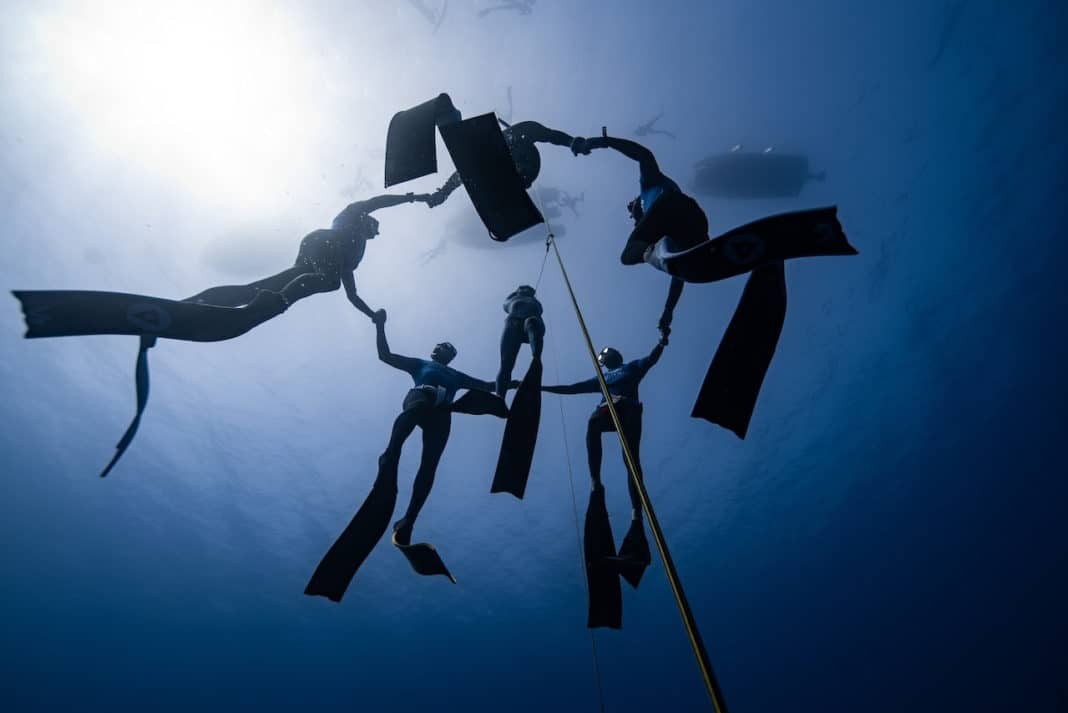Even though freediving has been a way for humans to gather food for about 8,000 years, organized official national and international freediving competitions only came into existence in the 1990s. Until recent years, all a spectator at a competition could do was watch the dive from the surface, with no idea what was going on under the surface, and competitions were not often televised for the rest of the world to see. In recent years, thanks to the underwater drone system called Diveye, live streams of competitions air on YouTube, allowing people to not only watch the competition above water but also see an athlete’s entire dive to depth from the comfort of their home.
This rise in popularity is why we created a three-part guide on how to watch a freediving depth competition, especially for those who are new to competitions or to freediving itself! Part One gives you useful terms regarding equipment, disciplines, techniques, and injuries, along with their definitions. Part Two discussed competition organization, the dive of an athlete itself, and how they are judged on it. In Part Three, we will cover the unsung heroes of the competitions: the safety team, medical team, and competition organizers.
Safety Team
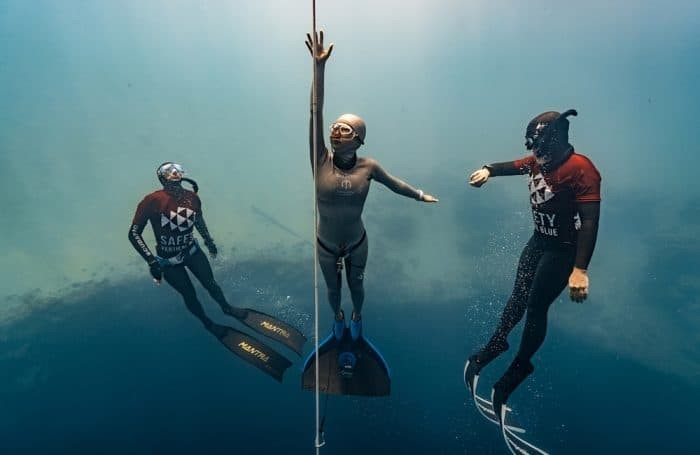
The safety team consists of very experienced safety divers whose job is to watch the athletes at the surface and at depth, constantly watching for any signs of trouble and assisting them if trouble does arise. At least two members of the safety team take turns diving to depth in a staggered formation, meeting the athlete at about 30m (98ft) of depth (although sometimes deeper), 20m (66ft), and 10m (33ft) if there is a third safety diver.
They create a system where they can give each other underwater signals with their arms extended in front of them, allowing them to communicate when they have seen the athlete if there is trouble, whether they need to activate the counter ballast system (the heavy counterweight that is activated to bring an athlete quickly back to the surface), and others. They may also communicate with the athlete underwater, making sounds with their throat to indicate that they have met them successfully. There is also a sonar monitoring the progress of the athlete and people assigned to watch the Diveye video feed, who can report on any trouble at depth.
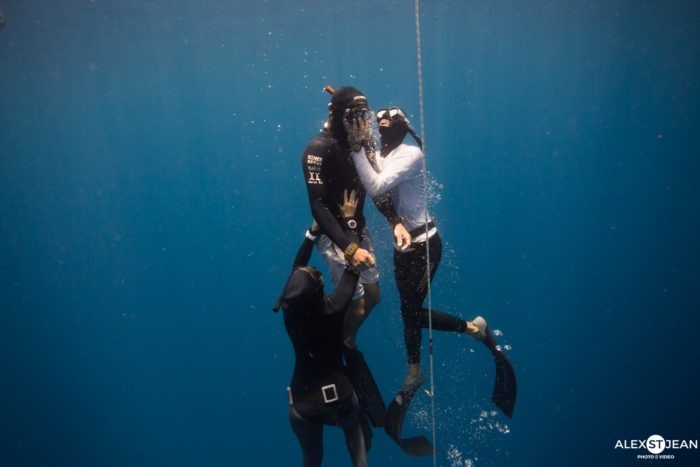
A safety team is organized before the competition, and they meet well in advance before the start of competition for multiple briefings, running drills and rescue simulations that include deep rescue, activating the counter ballast system, surface rescue, and transporting the incapacitated athlete to the platform or boat to be evacuated. It is important for them to develop a sense of deep trust with one another, and they are often affectionately named by athletes as “guardian angels.” Oftentimes, if athletes come before the competition to train, the safety divers will safety their dives and get to know the athlete’s style, giving them a better idea of individualized signs of trouble to look out for.
Medical Team
Competition rules state that at least one medical doctor with training in advanced trauma, airway management, and Advanced Cardiovascular Life Support (ACLS) and one nurse, paramedic, or lifeguard trained in ACLS is present. If there are more than 20 participants or if the competition spans over more than two days, there should be two medical doctors and two supporting medical staff members present. The members of the medical team bring an array of medical equipment and keep it within reach of the competition area, such as an automated external defibrillator, pure oxygen tanks, stretchers, bandages and antiseptics, and equipment for airway management.
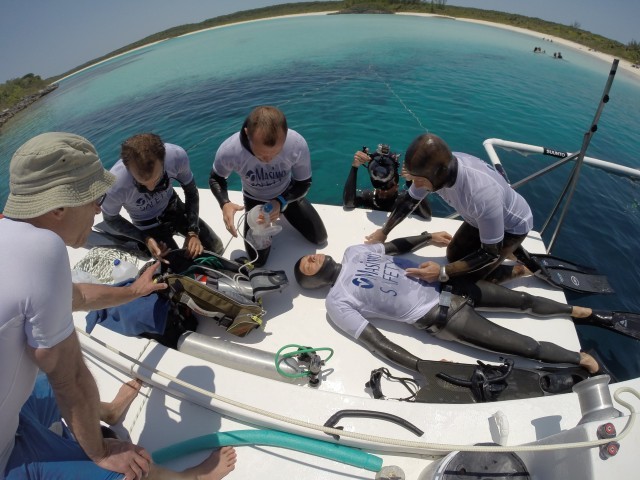
The most common issues that occur at competition consist of blackouts, pulmonary edema (as a result of pulmonary barotrauma), and ear and sinus barotrauma. Less common issues that can occur are thoracic barotrauma and decompression sickness; the medical staff is prepared for all. It should be noted that in the history of freediving competitions, there has only been a single death that occurred in an organized competition, and this is with over 50,000 competitive dives recorded to date.
Every single incident is reported, competition rules and regulations are always being updated, and the safety of every single person in the water always remains the number one priority. If an injury occurs, athletes are not allowed to continue participating in the competition without one of the medical doctors’ clearance. It is statistically safer to dive in freediving competitions than freediving recreationally, due to regulations in place and the presence of experienced safety and medical team.
Organizers
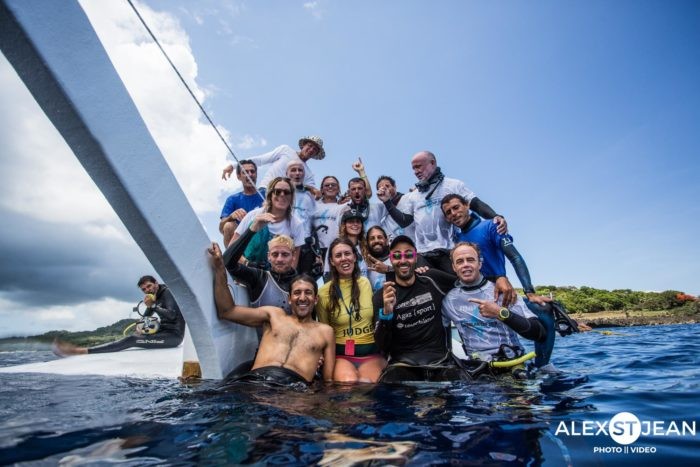
Organizers have the most responsibility out of everyone in a freediving competition. They must compose the medical team and confirm their qualifications, arrange the judges and safety team, organize the safety equipment, have complete procedures for an emergency, rescue, and evacuation plans, secure and test a counter ballast system, and conduct rescue simulations for the members of the safety and medical team.
Organizers must also know relevant emergency phone numbers (hospital, ambulance, evacuation boat, etc.), the responsible person and vehicle that will transport the injured person to the ambulance, the location of the water exit and route to the ambulance, location of the hospital, and location of decompression facilities, and the amount of time it takes to get to all of these locations.
Additionally, they must collect the announced performances of the athletes, create the event schedule and the start lists, and report the results. Neither the judges nor the record governing association are responsible for mishaps; it is only the organizer that is responsible for the entire event, who supervises over all of the parts that make the whole of the competition.
Watching and participating in freediving competitions is a privilege that could not be possible without a huge, collective effort from a group of talented individuals. This is why it is important to remember that while everyone watches the athletes on their screens, there is an entire team behind the athletes watching over them, ensuring their safety and giving us the gift of watching their dives.
We hope you enjoyed our guide to watching freediving competitions! If you have any questions, leave us a comment below!
Feature photo by Daan Verhoeven

